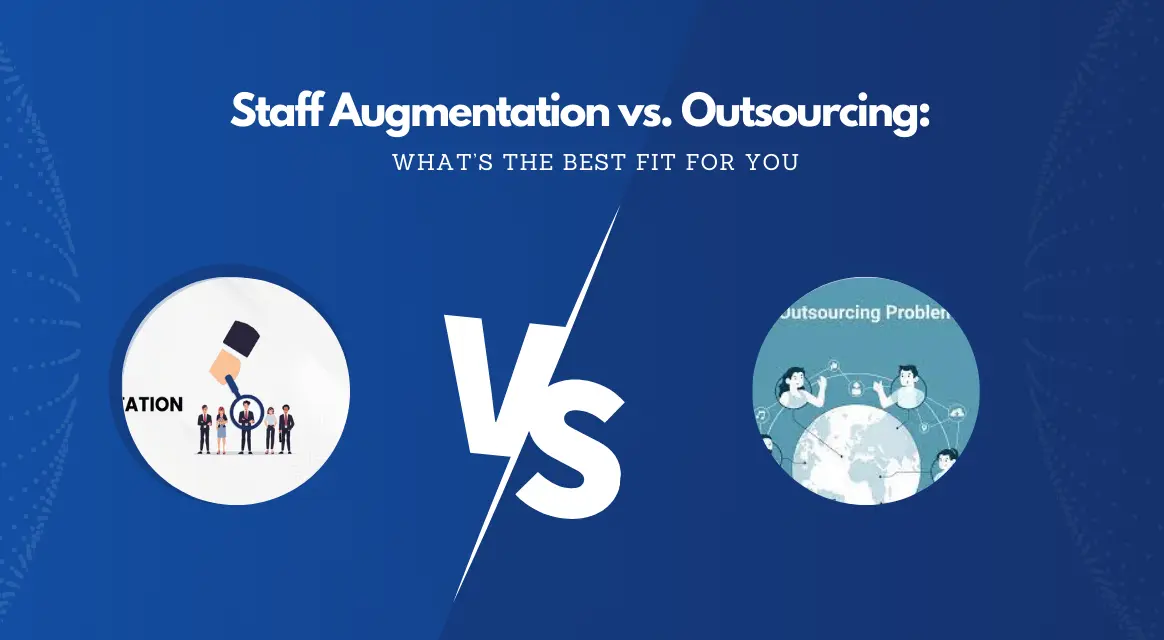In the current ever-shifting environment, organizations are always on the lookout for ways they can plug their workforce gaps, hire talent depending on their business’s need at a given time, and at the same time incur as few costs as possible.
Two popular models often emerge as top choices: Staff augmentation and outsourcing have been defined as follows, respectively. They are goals of filling the gaps of the resources as different but are suitable for different requirements and projects. Deciding between staff augmentation vs. outsourcing can be challenging without a clear understanding of their nuances.
This blog will guide you in selecting the right model suitable for your business by elaborating on the difference between the two. Whether you’re exploring IT staff augmentation services or considering outsourcing entire processes, this guide has you covered.
An Overall Understanding of Staff Augmentation
Staff augmentation is a hiring model under which companies recruit workers from outside to increase human resources for a particular project for a specific period of time. Think of it as a team extension where skilled experts join your in-house workforce for specific tasks or projects.
Types of Staff Augmentation Services
Flexibility:
Accommodation of changes in a project workforce in a short span can be done through expansion or contraction of the workforce.
Skill Access:
Temporarily staff a top-technology remote specialist in an area where your internal group has an information shortfall.
Cost Efficiency:
Do not make long-term employee contracts and attract only necessary skills while compensating correspondingly. For instance, a software development company might hire an AI specialist via IT staff augmentation services for a 6-month project, enabling them to leverage advanced skills without onboarding a full-time employee.
Basic Details of outsourcing
Outsourcing means that business activities within a particular company or administration are transferred to other companies or organizations. In terms of operational responsibility, outsourcing is more forceful than staff augmentation, which transfers responsibility to the vendor.
Key Features of Outsourcing
Complete Project Ownership:
Vendors are involved in planning and implementation of the GMPs.
Cost-Effectiveness:
Sometimes even a better option is to keep in-house teams for non-core activities as expensive.
Focus on Core Functions:
Relieves your organization’s internal staff to work on core competencies. For instance, a start-up can hire a firm to handle its customer support needs but conduct the services round the clock in contrast to hiring its own crew.
When to Choose Staff Augmentation
Staff augmentation is perfect for organizations that require temporary fortification of a workforce with specific expertise without compromising authority over things. Here are a few scenarios where IT staff augmentation services make sense:
Short-Term Skill Requirements
If you need a specialist, such as a mobile app developer or a DevOps engineer, for a temporary project, team extension through staff augmentation is cost-effective.
Project Expansion
In cases where projects start getting complicated, hiring experts is useful because your key staff is not overwhelmed while at the same time ensuring that projects are completed within the right time.
In-House Project Management
If you have robust project management capabilities and prefer to maintain direct oversight, IT staff augmentation services offer the required flexibility.
Example
An American financial services firm that is implementing a blockchain solution for payment processing may require external blockchain developers for 6 months for the project.
When to Opt for Outsourcing
Outsourcing is most effective when companies follow the strategy of outsourcing a particular process or project as a whole. This is especially useful for startups and companies that are interested in maintaining focus in their areas of specialization.
End-to-End Project Execution
Outsourcing can be useful in tasks that you are not equipped to handle within the company, for instance, software development or marketing campaigns.
Focus on Core Operations
Outsourcing helps in focusing more internal resources on strategic business activities.
Cost Savings
Outsourcing to vendors from other areas of operations where labor is expensive lowers the operational costs significantly.
Example
A startup can hire an agency to develop an entire eCommerce website, which will not only be professional, but the startup would not invest in building a tech team.
Pros and Cons of Each Approach
Staff Augmentation: Pros and Cons
Pros
Flexibility: Resource scaling by following the need of the project to be accomplished.
Cost-effective: It is advisable to purchase the skills you require and always avoid full-salary engagements.
Team Integration: Augmented staff operates as part of your organization’s staff.
Cons
Management Overhead: When the use of augmented staff is inevitable, you will still have to deal with them in one way or another.
Cultural Fit: Temporary resources may require time to positively adapt to your organizational environment.
Outsourcing: Pros and Cons
Pros
Reduced Burden: This way, vendors take responsibility for project implementation, so your staff does not need to worry about it.
Cost Savings: Most effective where the processes are standardized or are of marginal strategic importance.
Access to Expertise: External vendors bring expertise to their specialist fields and are industry-savvy.
Cons
Limited Control: They have limited control over the exercise of the process.
Dependency on Vendors: Hence, success is highly associated with the reliability of vendors.
Hybrid Approach: Blending between Staffing and Outsourcing
In certain cases, combining IT staff augmentation services and outsourcing can provide the best of both worlds.
For example, you can turn over routine processes and tasks while hiring talent through staff augmentation for time-sensitive projects that call for special talents.
Example of a Hybrid Approach
An organization can subcontract data entry services while employing augmented data scientists to help make better analyses of trends.
Concluding Thoughts
Both staff augmentation vs. outsourcing offer distinct advantages and the choice largely depends on your business requirements. If you need a flexible team extension to enhance your in-house capabilities temporarily, IT staff augmentation services are the way to go.
However, outsourcing as a type of off-sourcing is more suited to establishments that seek to delegate whole functions or projects, leaving all responsibility to the third party engaged in the performance of the said functions or undertaking the said projects.
The ability to make the correct decision is dependent on being aware of your goals and what is required in your project. Knowing which model is right for a certain business will avoid pitfalls, expensive constraints, and overall failures of projects.
For Latest Update – Empireadda



